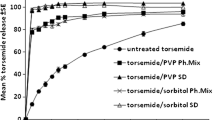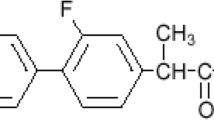Abstract
The aim of this study was to optimize and formulate fast disintegrating tablets (FDTs) for nausea and vomiting using aminoacetic acid, carmellose and sodium alginate with enough mechanical strength. Ondansetron HCl (water soluble) or domperidone (water insoluble) drug were added to FDTs and their disintegration behaviour was evaluated. Plackett Burman Screening Design was used to screen the independent active process variables [concentration of aminoacetic acid (X 1), concentration of carmellose (X 2) and tablet crushing strength (X 3)] which were found to actively influence the dependent variables [disintegration time in the mouth (DT), wetting time (WT), and water absorption ratio (WAR)] for both the drugs. Also, the coefficients of active variables (DT, WT and WAR) of FDTs containing domperidone was found to be significantly different (P < 0.05) from the coefficients of active factors (X 1, X 2 and X 3) containing ondansetron HCl FDTs. Further, FDTs containing domperidone was prepared according to central composite design for estimating the effect of active factors (X 1, X 2, X 3) in extended spherical domain. The regression analysis of quadratic fit revealed that DT, WT and WAR were 98% correlated with active factors (X 1, X 2 or X 3). The optimized domperidone FDTs were further compared with superdisintegrants (croscarmellose sodium or crospovidone). The data revealed that optimized domperidone FDTs were better than domperidone FDTs containing croscarmellose or crospovidone. Hence, this novel excipients combination can be used for delivery of water insoluble drugs in place of superdisintegrants.



Similar content being viewed by others
References
R. K. Chang, X. Guo, B. A. Burnside, and R. A. Couch. Fast dissolving tablets. Pharm. Technol. 24:52–59 (2000).
L. Mallet. Caring for the elderly patient. J. Am. Pharm. Assoc. 36:628 (1996).
H. Seager. Drug delivery products and the Zydis fast dissolving dosage. J. Pharm. Pharmacol. 50:375–382 (1998).
S. R. Parakh, and A. V. Gothoskar. A review of mouth dissolving technologies. Pharm. Technol. 27:92–100 (2003).
S. Schiemeir, and P. C. Schmidt. Fast dispersible ibuprofen tablets. Eur. J. Pharm. Sci. 15:295–305 (2002).
J. Fukami, A. Ozawa, Y. Yoshihashi, E. Yonemochi, and K. Terada. Development of fast disintegrating compressed tablets using amino acid as disintegration accelerator: Evaluation of wetting and disintegration of tablet on the basis of surface free energy. Chem. Pharm. Bull. (Tokyo). 53:1536–1539 (2005).
I. I. Salem, J. M. R. Lopez, and A. C. Galan. Ondansetron hydrochloride. In H. G. Brittain (ed.), Analytical Profiles of Drug Substances and Excipients, vol. 27, Academic, California, 2001, pp. 301–308.
J. E. Hoover. Gastrointestinal and liver drugs. In: Hendrickson R (ed) Remington:The Science and Practice of Pharmacy, 21st edn, Lippincott Williams & Wilkins, USA, PA, 2006, p. 1311.
J. Fukami, B. Yonemochi, Y. Yoshihashi, and K. S. Terada. Evaluation of rapidly disintegrating tablets containing glycine and carboxymethylcellulose. Int. J. Pharm. 310:101–109 (2006).
U. S. Pharmacopoeia. USP 30-NF25, USP, Rockville, MD, 2007.
V. B. Sutariya, R. C. Mashru, M. G. Sankalia, and J. M. Sankalia. Preparation of rapidly disintegrating tablets of ondansetron hydrochloride by direct compression method. Ars. Pharm. 47:293–311 (2006).
G. A. Lewis, D. Mathieu, and R. Phan-Tan-Luu. The scope of experimental design. In G. A. Lewis, D. Mathieu, and R. Phan-Tan-Luu (eds.), Pharmaceutical Experimental Designs, Marcel Dekker, NewYork, 1999, p. 50.
X. Y. Bi, H. Sunada, Y. Yonezawa, and Danjo. Evaluation of rapidly disintegrating tablets prepared by a direct compression method. Drug Dev. Ind. Pharm. 25:571–581 (1999).
Acknowledgements
We gratefully acknowledge Panacea Biotech Ltd. (Lalru, India), Nayan Pharmaceuticals Ltd. (Patiala, India) and Ind-Swift Labs, (Chandigarh, India) for providing gift samples of superdisintegrants, domperidone and ondansetron HCl, respectively for this invstigation.
Author information
Authors and Affiliations
Corresponding author
Rights and permissions
About this article
Cite this article
Goel, H., Vora, N. & Rana, V. A Novel Approach to Optimize and Formulate Fast Disintegrating Tablets for Nausea and Vomiting. AAPS PharmSciTech 9, 774–781 (2008). https://doi.org/10.1208/s12249-008-9113-1
Received:
Accepted:
Published:
Issue Date:
DOI: https://doi.org/10.1208/s12249-008-9113-1




